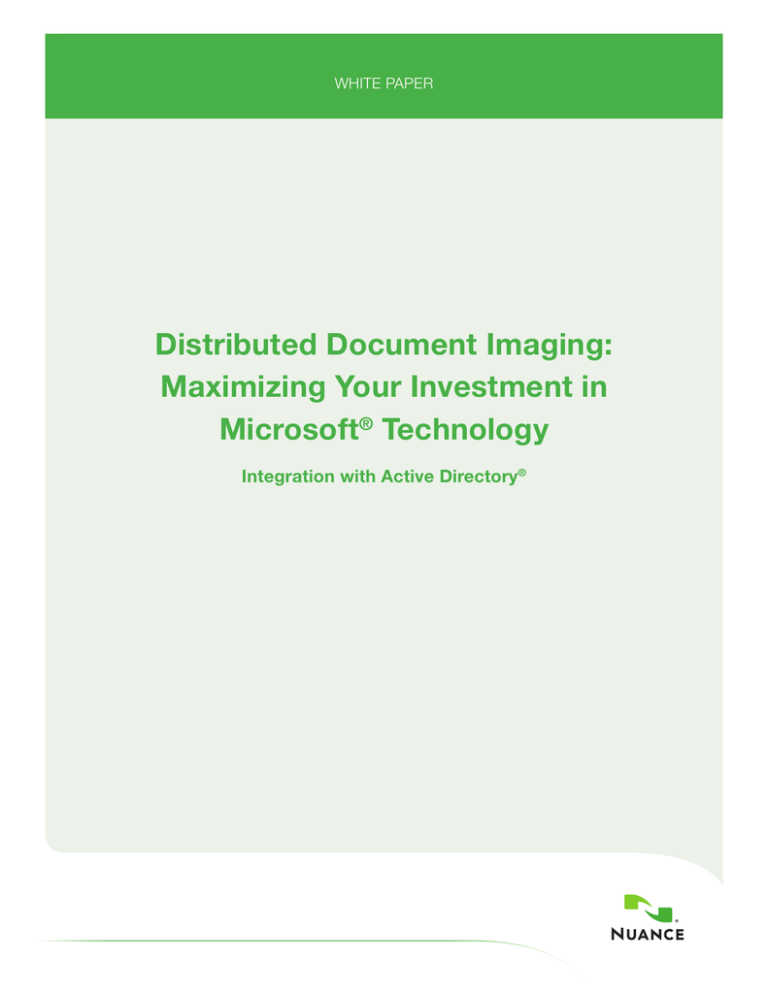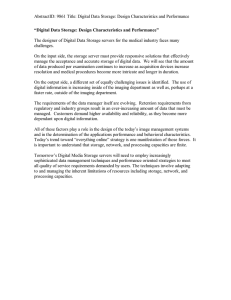
WHITE PAPER
Distributed Document Imaging:
Maximizing Your Investment in
Microsoft® Technology
Integration with Active Directory®
White Paper | Distributed Document Imaging: Maximizing Your Investment in Microsoft ® Technology
Contents
Introduction ............................................................................................................................................... 1
Distributed Document Imaging in Microsoft IT Infrastructures… ................................................................. 2
Authentication and security........................................................................................................................ 2
Lowering total cost of ownership ............................................................................................................... 2
Implementing access controls ................................................................................................................... 3
Personalization at the device ..................................................................................................................... 3
Handling complex environments ................................................................................................................ 4
Summary ................................................................................................................................................... 4
© 2009 Nuance Communications, Inc. All rights reserved.
Nuance Document Imaging Solutions
ii
White Paper | Distributed Document Imaging: Maximizing Your Investment in Microsoft ® Technology
Introduction
Given the fundamental role of Active Directory (AD) in the IT infrastructure, any distributed document imaging
solution must integrate with AD for purposes of security, administration, and ease-of-use:
• The authentication process at the device must mirror the authentication process at the Windows desktop,
using the same AD logon credentials and secure protocols.
• Having logged on, users must be able to access the applications they are authorized to use without logging
on again. To do this, the solution must leverage AD’s single sign-on feature, which automatically unlocks
applications, including 3rd-party applications, which use Windows integrated authentication.
• The user’s existing AD profile must determine the level of access to various network resources from the
scanning device. Users must be able to scan documents to the same libraries, databases, folders, etc. they
use from their desktop, but must be prohibited from accessing those for which they do not have access
rights.
This eCopy technology brief is one in a series of four briefs that examine the requirements for successfully
integrating a distributed document imaging application into your existing Microsoft-focused IT environment.
Other technology briefs in this series include:
• Exchange
• SharePoint
• SQL Server / Access
The other three technology briefs in this series can be downloaded from our Web site.
© 2009 Nuance Communications, Inc. All rights reserved.
Nuance Document Imaging Solutions
1
White Paper | Distributed Document Imaging: Maximizing Your Investment in Microsoft ® Technology
Distributed Document Imaging in Microsoft IT Infrastructures
Distributed document imaging solutions enable knowledge workers to convert paper documents into
electronic files.
As a result, these solutions offer significant benefits, including:
• Making paper-based information available throughout the organization
• Speeding up the processing of paper documents while simultaneously reducing the associated
costs
• Enabling administrators to apply policies for compliance with records management and security
regulations
• Safeguarding paper documents through electronic backup to offsite facilities
To achieve these benefits, the imaging application must be easy to use and must integrate with the
applications people already use on a daily basis for communication, collaboration, and document
storage. Users must be able to walk up to any scanning device and store, distribute, and share paper
documents the same way they handle electronic files at their desktop – by browsing the network, storing
files to pre-configured locations, selecting recipients from address lists, and indexing documents for
quick retrieval.
For organizations with Microsoft-focused IT infrastructures, this means integrating with the Microsoft
technologies and applications already in place, such as Active Directory®, Exchange, SharePoint®, and
SQL Server®-based business management applications.
Dynamic integration with back-end servers (domain controllers, Exchange servers, SharePoint servers,
etc.) through programmed interfaces ensures that the user interface reflects the latest changes to the
underlying applications, directories, and site structures. It also eliminates the need for preconfigured
scanning cover sheets that some imaging solutions require. The application interfaces must be
sophisticated enough to handle the infinite variety of complex network environments involving multiple
domains, multiple forests, outsourced IT management, and internet-hosted services.
Authentication and security
An ideal distributed imaging application uses the Security Support Provider Interface (SSPI) to negotiate the
best protocol (frequently Kerberos or NTLM) based on the security policies in place.
If capturing user credentials on a non-Windows platform (for example, an imaging client running on the MFP’s
embedded computing engine), the client must use a secure protocol, like Triple DES or SSL, to ensure the
credentials cannot be intercepted during transfer over the network.
Lowering total cost of ownership
Some distributed imaging solutions require manual account setup for each user. This adds significantly to
the administrative workload, since IT staff must continually add, modify, and delete accounts as employees
transition throughout the organization.
© 2009 Nuance Communications, Inc. All rights reserved.
Nuance Document Imaging Solutions
2
White Paper | Distributed Document Imaging: Maximizing Your Investment in Microsoft ® Technology
It also compromises security, since manual processes are error-prone and subject to delayed implementation.
Integration with AD eliminates the need to manage separate user lists and passwords, dramatically reducing
the need for IT intervention and thereby lowering the total cost of ownership. When an IT administrator creates
a new user account, that user is automatically configured to use the scanning device, subject to any restrictions
associated with existing group policies.
AD maintains links between user accounts, mailbox accounts, and applications, so a single change updates
the user information for all applications and services. If the imaging application is tied into the same account
management database, the rights and restrictions associated with that user propagate immediately to each
scanning device. Similarly, password changes are applied automatically to all AD-integrated applications.
Implementing access controls
An ideal distributed imaging solution integrates with the existing AD organizational structure.
The Organizational Unit (OU) is the level at which administrative controls are typically delegated, and
administrators may need to limit access to devices to those within a specific OU. By enabling administrators to
restrict access to certain branches of the organizational hierarchy, administrators can effectively control access
to devices with minimal effort.
For example, a college has MFP devices located in common areas. The administrator needs to restrict access
so that students and faculty can use “scan to email” but only faculty can use “scan to folder.” Although
students and faculty have accounts on the same domain, students are in the “Students” OU, while faculty
members are in the “Faculty” OU. In this case, the administrator can provide general access to both OUs but
limit “scan to folder” access to OU=Faculty.
Personalization at the device
When a user logs on through an AD-integrated imaging application, the application can access the information
in the user’s AD profile.
For example, the application can read the user’s “Home
Directory” attribute and make that location immediately
available for storing scanned documents without requiring
any folder navigation or selection. When browsing the
network, personalization ensures that users can see only
folders they are allowed to access.
Imaging applications that support AD-integrated applications
like Microsoft Exchange or SharePoint (both covered in
other documents in this series) can make extensive use of
personalization. Exchange integration can provide the user
with access to personal contacts and distribution lists, while
SharePoint integration can filter available destinations and
pre-populate available content types and metadata based
on the user’s profile.
© 2009 Nuance Communications, Inc. All rights reserved.
Users logging on through an AD-integrated
imaging application can only see the folders
they are allowed to access.
Nuance Document Imaging Solutions
3
White Paper | Distributed Document Imaging: Maximizing Your Investment in Microsoft ® Technology
Handling complex environments
In a multi-domain forest, each domain stores information about objects in that domain only.
For example, a user in “Domain A” is stored only on Domain A’s domain controllers, while a device in “Domain
B” is stored only on Domain B’s domain controllers. In this type of environment, a distributed imaging solution
must enable users in Domain A to access devices in Domain B.
In a multi-forest environment, cross-forest authentication enables secure access to resources when the user
account is in one forest and the capture device is in another forest. This enables users to work securely without
sacrificing the single sign-on and administrative benefits of having only one user ID and password.
Access to resources in other domains or forests is supported
through trust relationships and global catalog servers. In a multidomain or multi-forest environment, therefore, it is important that
the distributed imaging application can communicate with global
catalog servers, and not just with servers within the local domain
or forest.
Summary
Ideally, a distributed imaging solution should bring the user’s
existing Windows environment to the scanning device.
Integration with Active Directory makes that possible. Doing so
virtually eliminates any administrative overhead, since the solution
ties into the existing user management infrastructure.
Considerations when selecting a distributed imaging solution:
• Does the authentication process at the device mirror the
authentication process at the Windows desktop, using the
same user credentials and the same secure protocols?
• Does the solution integrate with AD to restrict access to
applications and resources based on the user’s AD profile and
the groups to which the user is assigned?
A multi-forest environment with crossforest authentication.
• Once logged on, can users access any of the applications they
are authorized to use without having to log on again?
• Can the administrator restrict device access to those below a specified DN (Distinguished Name) in the
organizational hierarchy?
• Can the solution filter available options and pre-configure certain fields based on the user’s identity?
• Does the solution work in complex multi-domain and multi-forest environments?
© 2009 Nuance Communications, Inc. All rights reserved. Nuance and the Nuance logo, are trademarks or registered trademarks of
Nuance Communications, Inc. or its affiliates in the United States and/or other countries. All other trademarks referenced herein are the
property
of their
respective
owners.
© 2009
Nuance
Communications,
Inc. All rights reserved.
Nuance Document Imaging Solutions
4
L-
The experience speaks for itself ™
NUANCE COMMUNICATIONS, INC.
ONE WAYSIDE ROAD
781 565 5000
BURLINGTON, MA 01803
NUANCE.COM







